
All About Lockout / Tagout Devices
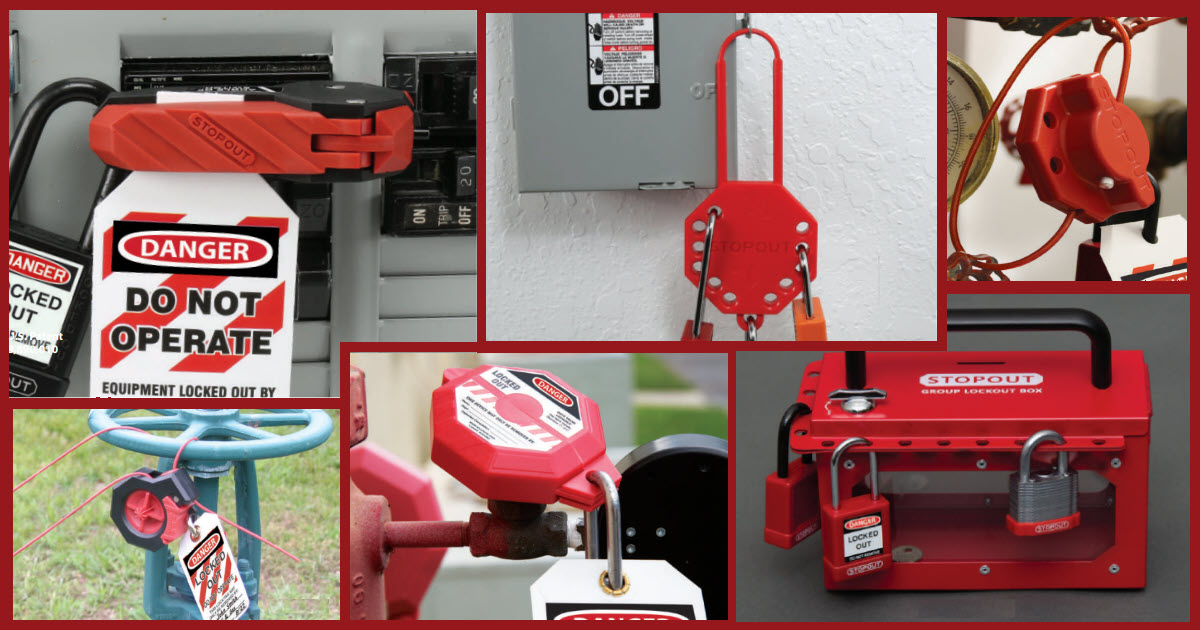
Controlling the release of hazardous energy is the most important thing you can do to protect others from electrical hazards. Prevent worker injuries by properly controlling and locking out hazardous energy with durable lockout devices labeled with lockout tags.
To stop serious electrocutions and other injuries from occurring, OSHA 29 CFR 1910.147 highlights standards designed to prevent accidents due to accidental start-ups. The practices and procedures highlighted by OSHA require safety lockout/tagout devices to disable machinery or equipment in order to prevent the hazardous release of an energy source while performing service or maintenance.
What are Lockout / Tagout Devices?
Lockout devices are a lock with either a key or combination type, designed to hold an energy isolating device in the safe position and prevent the energizing of machinery or equipment. Tagouts are prominent warning devices, such as a tag and a means of attachment, that can be secured to an energy isolation source. They should not be removed until work is complete.
Before assigning your workers to perform service or maintenance on machinery or equipment, double check they have the appropriate safety lockout / tagout devices and tags.
Additionally, ensure only trained or authorized employees are working with hazardous energy. Per OSHA, employer’s have responsibility to develop, document, and use energy-control procedures that establish a sequence of actions to follow whenever re-energization is required as a part of a service or maintenance activity.
What are OSHA Requirements?
- Label it! Label all lockout/tagout locks to identify the specific employees authorized to apply and remove them
- Make sure your lockout device is durable. Lockout/tagout devices must not deteriorate or become obscured even when used with corrosive components such as acid, alkali chemicals, or in wet environments.
- Devices need to be substantial. Employees should be able to remove locks only by using excessive force with special tools such as bolt cutters or other metal-cutting equipment. Lock Out Tags must be non-reusable, self-locking, and non-releasable, with a minimum unlocking strength of 50 lbs. Tags must be attachable by hand, and need to withstand all environments and conditions.
- Standardization is important. Lockout/tagout item color, shape, or size must be standardized in print and format, and must be legible and understandable by all employees. They must warn employees about hazards if the machine is energized, and offer employees clear instructions. Examples: “Do Not Start,” “Do Not Open,” “Do Not Close,” “Do Not Energize,” or “Do Not Operate.”
When a group of workers is working on the same equipment or machinery, ensure they’re using a Group Lockbox to allow all workers to be on a lockout. Each employee in the group must have control over the sources of hazardous energy while he or she is involved in the activities covered by the standard. Personal control is attained when each authorized employee affixes personal lockout/tagout devices to the group lockout mechanism, instead of relying on the supervisor to provide protection against the hazardous energy.
Lockout Tagout Tags
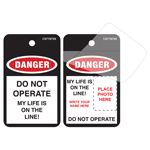 | 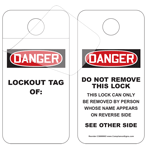 | 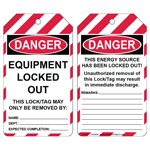 | 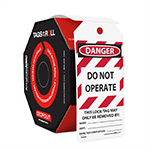 |
Common Lockout / Tagout Devices and Uses:
Cable Lockouts: A long cable that goes around various isolating components and secures with a padlock
Chain Lockouts: Can be used to block entrances and keep people out of large areas
Circuit Breaker Lockouts: Provide isolation for circuit breakers
Energy Source Identification: Identify equipment names and energy sources with safety tags
Hasps: Lock out a single energy control on electrical equipment and machines
Lock Boxes: Hold all lockout keys to ensure they are not accessible until workers complete all tasks
Lockout Center Boards: Store LOTO supplies in one place to ensure compliance with safety protocols
Lockout Documentation: Training forms, booklets, binders and other documentation
Lockout Kits: Device collections that include necessary safety devices and tools
Padlocks: Keyed locks used to secure lockout devices
Plug Lockouts: Prevent plugs from being inserted into outlets (plugged in), thus controlling energy to the machine
Security Seals: A one-way style lock that can only be removed when the seal is broken. This makes it obvious that the lockout item has been tampered with.
Switch Lockouts: Removable rotary or push-button switch covers that prevent access to controls
Valve Lockouts: A lockout device that secures the operational portion of a valve
Worksite Lockouts: Items such as steering wheel covers or ladder shields warn workers and prevent unauthorized access to specific items.
OSHA Lockout/Tagout Color Codes
OSHA does not require specific color codes for LOTO, but it recommends the following:
- Orange: for warning signs
- Yellow: to designate caution
- Red: to indicates danger
- Fluorescent orange: to label biological hazards
LOTO Device Resources:
- Review OSHA Lockout/Tagout standards.
- Review our Lockout Tagout Guide.
- Visit ComplianceSigns.com for all kinds of safety tags.
- AccuformNMC carries a wide range of worksite lockout devices.

